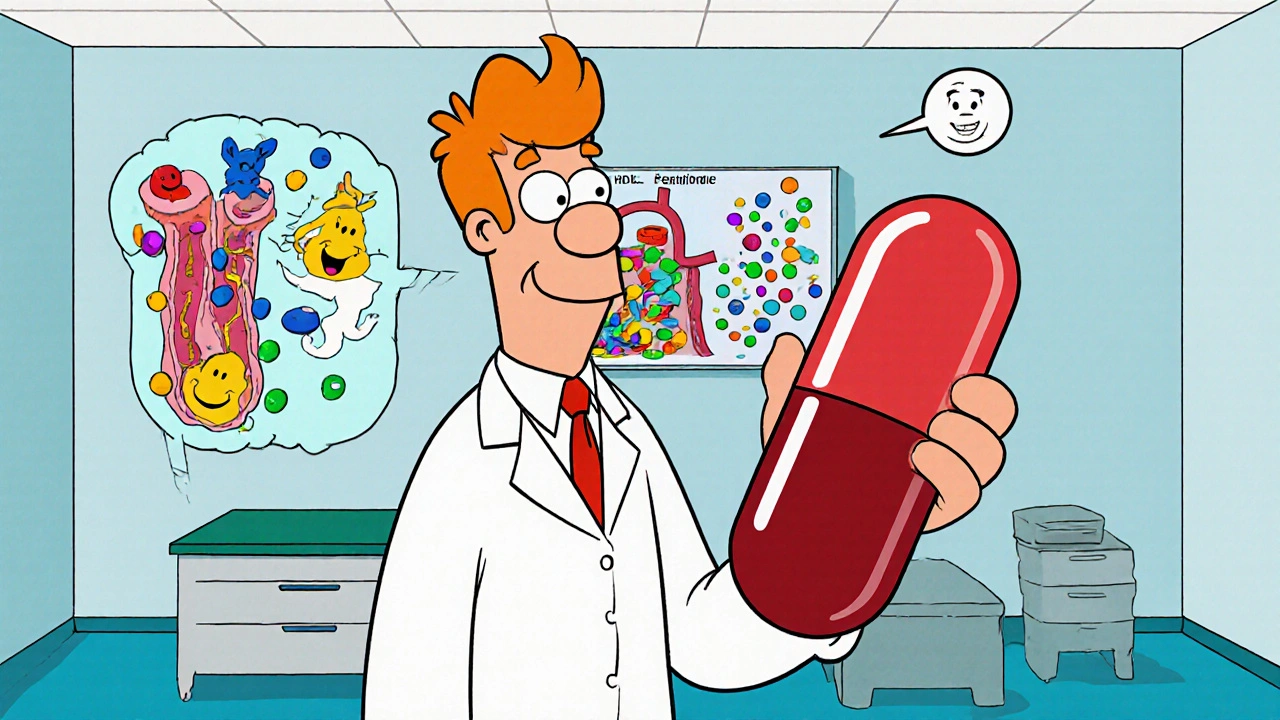Fenofibrate Triglyceride Reduction Calculator
Fenofibrate typically reduces triglyceride levels by 30-50%. This calculator shows your expected triglyceride range after treatment.
When you hear the word fenofibrate, you might think it’s just another cholesterol pill. In reality, it plays a specific role in lowering triglycerides and modifying lipoprotein profiles, which can help cut the risk of heart disease. This article breaks down exactly how fenofibrate works, who benefits most, and what to watch out for, so you can decide if it belongs in your heart‑health plan.
What is Fenofibrate?
Fenofibrate is a prescription medication classified as a fibric acid derivative that activates peroxisome proliferator‑activated receptor alpha (PPAR‑α). By turning on PPAR‑α, it speeds up the breakdown of triglyceride‑rich particles and raises “good” HDL cholesterol. First approved in the United States in 1998, fenofibrate has become a go‑to option for patients with high triglycerides that don’t respond well to statins alone.
How Does Fenofibrate Fit into Heart Disease Prevention?
Heart disease risk is driven by several lipid factors: high LDL cholesterol, low HDL cholesterol, and especially elevated triglycerides. While statins excel at dropping LDL, they only modestly affect triglycerides. Fenofibrate targets the latter, reducing triglyceride levels by 30‑50% on average. Lower triglycerides translate into fewer atherogenic remnant particles, which can infiltrate arterial walls and spark plaque formation.
Clinical trials such as the ACCORD Lipid Study and the FIELD trial have shown that adding fenofibrate to statin therapy can further lower the incidence of major cardiovascular events in patients with combined dyslipidemia (high triglycerides + low HDL). The benefit is most pronounced in people with diabetes or metabolic syndrome, where triglyceride excess is a key driver of atherosclerosis.
Key Lipid Targets of Fenofibrate
- Triglycerides - Primary lipid reduced; typical drop 30‑50%.
- HDL cholesterol - Often rises 10‑20%.
- LDL cholesterol - Small modest reduction (5‑10%).
Who Should Consider Fenofibrate?
Not everyone with high cholesterol needs fenofibrate. Ideal candidates include:
- Patients with fasting triglycerides >200mg/dL despite lifestyle changes.
- Individuals with metabolic syndrome or type2 diabetes where triglycerides are a major risk factor.
- People already on a statin who still have a mixed lipid profile (high TG, low HDL).
- Patients who cannot tolerate higher‑dose statins due to side effects.
Always discuss with a healthcare provider, as the drug’s benefits must outweigh potential risks such as liver enzyme elevation or muscle complaints.

Safety Profile and Common Side Effects
Fenofibrate is generally well‑tolerated, but like any medication, it can cause issues. The most frequently reported side effects are:
- Gastrointestinal upset - nausea, abdominal pain.
- Elevated liver enzymes - monitored through routine blood tests.
- Muscle pain or weakness - especially when combined with a statin (monitor creatine kinase).
- Kidney function changes - dose adjustment needed in chronic kidney disease.
Serious adverse events such as rhabdomyolysis are rare, but the risk increases if fenofibrate is taken with high‑dose statins.
Comparing Fenofibrate with Other Lipid‑Lowering Options
| Drug Class | Mechanism | Primary Lipid Target | Typical Dose | Common Side Effects | Outcome Evidence |
|---|---|---|---|---|---|
| Fenofibrate (Fenofibrate) | PPAR‑α activation | Triglycerides ↓, HDL ↑ | 145mg daily | GI upset, ↑LFTs, muscle pain | ACCORD & FIELD show modest CV risk reduction in high TG diabetics |
| Statins (e.g., Atorvastatin) | HMG‑CoA reductase inhibition | LDL ↓ | 10‑80mg daily | Myalgia, ↑LFTs, rare rhabdo | Robust reduction in MI, stroke, death across populations |
| Niacin | Inhibits hepatic diacylglycerol acyltransferase | HDL ↑, TG ↓ | 500‑2000mg daily | Flushing, hyperuricemia, hepatotoxicity | Recent trials show limited additional CV benefit |
| Omega‑3 Fatty Acids (e.g., icosapent ethyl) | EPA/DHA incorporation into phospholipids | Triglycerides ↓ | 2g daily | Fishy aftertaste, GI upset | REDUCE‑IT trial showed 25% CV event reduction in high TG patients |
The table makes clear that fenofibrate’s niche is triglyceride reduction with a modest impact on overall cardiovascular outcomes, especially when added to a statin regimen.
Monitoring and Follow‑Up
When you start fenofibrate, your doctor will schedule baseline labs: fasting lipid panel, liver function tests (ALT, AST), and creatine kinase if you’re on a statin. Follow‑up labs are typically done after 6‑8 weeks, then annually if stable. Adjustments are made based on triglyceride response and any signs of liver or muscle toxicity.

Real‑World Tips for Getting the Most Out of Fenofibrate
- Take it with food. Absorption improves, and stomach upset is less likely.
- Stay hydrated - helps kidneys clear the drug.
- Combine with a Mediterranean‑style diet: fatty fish, nuts, olive oil, and plenty of fiber.
- Exercise regularly - even modest activity can lower triglycerides further.
- Never double‑dose to “catch up” if you miss a pill; just skip it and continue the schedule.
These lifestyle tweaks amplify the drug’s effect and often allow lower doses, reducing side‑effect risk.
When Fenofibrate Might Not Be the Right Choice
Consider alternative strategies if you have:
- Severe liver disease (ALT >3× ULN).
- Stage4 or 5 chronic kidney disease without dose adjustment.
- Pregnancy or breastfeeding - safety not established.
- Allergy or hypersensitivity to fibric acid derivatives.
In such cases, omega‑3 supplements, niacin, or newer agents like bempedoic acid may be safer options.
Bottom Line: Is Fenofibrate Worth It for Heart‑Disease Prevention?
If you already control LDL with a statin but still wrestle with high triglycerides, fenofibrate adds a targeted, evidence‑backed layer of protection. Its benefits shine most in diabetic or metabolic‑syndrome patients where triglycerides drive risk. For the average person with normal TG levels, the added drug may offer little extra benefit and expose you to unnecessary side effects.
Talk to your healthcare provider, get baseline labs, and weigh the pros against the cons. When used right, fenofibrate can be a valuable piece of a broader heart‑health puzzle.
Frequently Asked Questions
Can I take fenofibrate with my statin?
Yes, many doctors prescribe fenofibrate alongside a moderate‑dose statin to target both LDL and triglycerides. However, monitor muscle enzymes because the combo slightly raises the risk of myopathy.
How long does it take to see a drop in triglycerides?
Most patients notice a 20‑30% decline within 2‑4 weeks, with the full 30‑50% reduction stabilizing by 8‑12 weeks.
Are there natural alternatives to fenofibrate?
Dietary omega‑3 fatty acids (e.g., fish oil), regular exercise, and weight loss can lower triglycerides, but they may not achieve the same magnitude of reduction as a prescription agent.
What should I do if I experience muscle pain?
Stop the medication and contact your doctor. They may check creatine kinase levels and decide whether to adjust the dose or switch therapies.
Is fenofibrate safe for people over 65?
Older adults can use fenofibrate, but kidney function should be assessed first, and doses may need lowering to avoid accumulation.


CHIRAG AGARWAL
Fenofibrate can knock down triglycerides, but it’s not a magic bullet; you still need diet and exercise to keep the heart healthy.
Take it with food, watch liver enzymes, and don’t expect it to replace a statin if LDL is high.